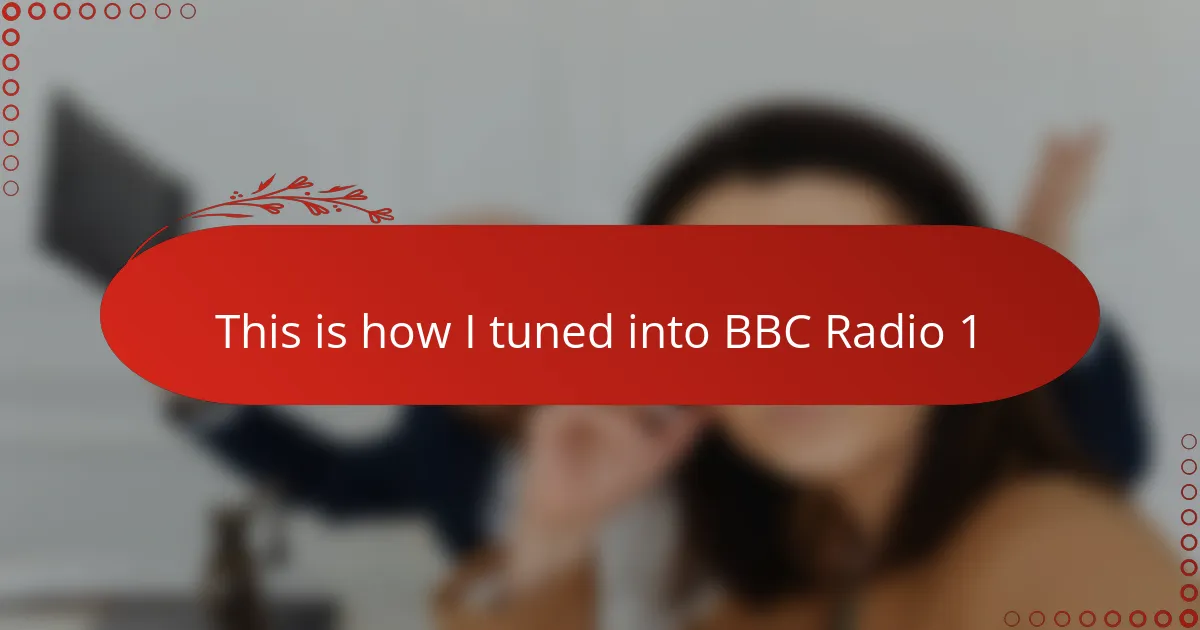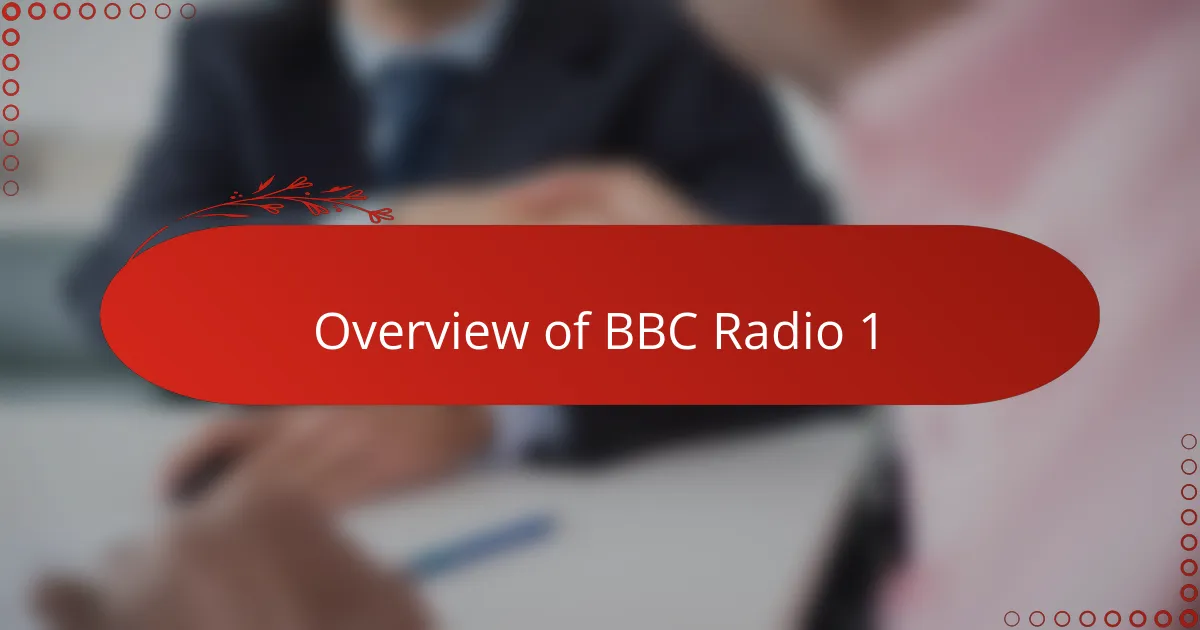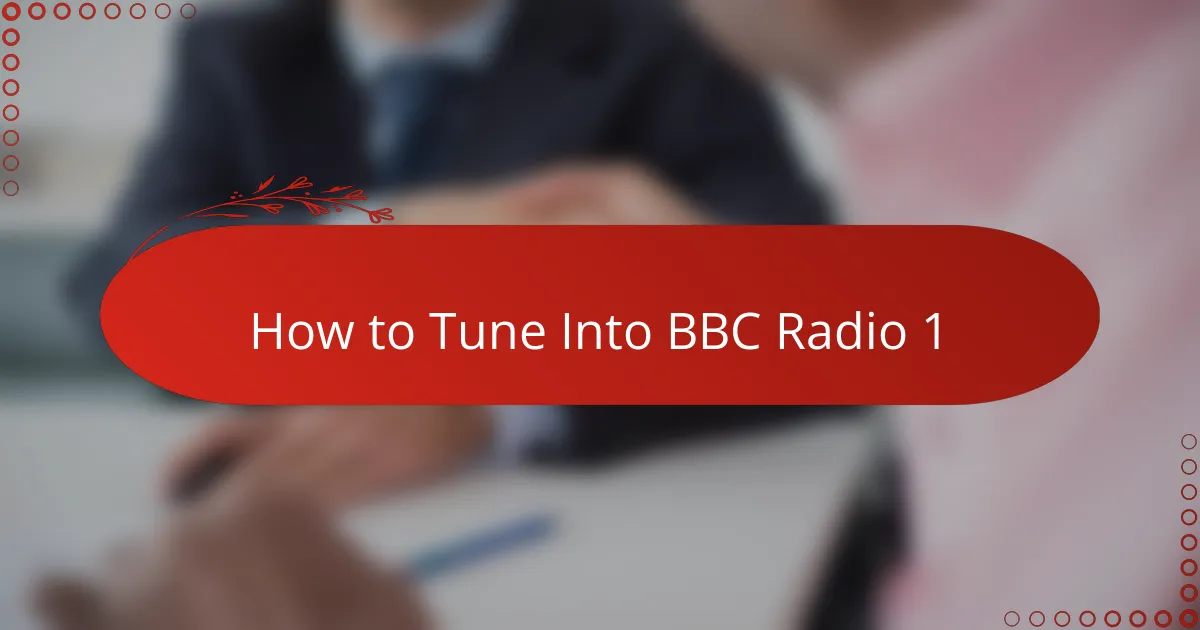Key takeaways
- Radio broadcasting transmits audio signals using various frequencies, combining technology with creativity to provide a rich listening experience.
- Different types of radio stations, including commercial, public, community, and internet-only, serve diverse audiences and promote unique content.
- BBC Radio 1 stands out for its dynamic blend of popular music and cultural relevance, enriching listeners’ experiences with exclusive sessions and interviews.
- Tuning into radio stations has evolved with technology, offering methods like DAB, online streaming, and voice commands for enhanced accessibility and convenience.

Understanding Radio Broadcasting Basics
Radio broadcasting, at its core, is all about transmitting audio signals through the airwaves so that listeners can tune in from anywhere. When I first dove into this world, I was fascinated by how these invisible waves carried voices and music straight into my living room. It made me wonder—how does something intangible like a radio wave become a vivid listening experience?
Understanding frequency and modulation opened my eyes even more. I learned that Radio 1, like many stations, uses specific frequencies to make sure their signal reaches the right audience without interference. It’s like tuning a musical instrument perfectly; when you get it right, the sound is crystal clear.
Ever thought about what happens behind the scenes every time you press “play” on your car radio? I did, and realizing that an entire network of transmitters, antennas, and studios works seamlessly to bring you real-time content made me appreciate radio broadcasting on a whole new level. It’s a blend of science and art, technology and passion.

Types of Radio Stations
When I started exploring radio stations, I quickly realized they come in many flavors. There are commercial stations, which you probably know well—they play popular music and run ads to keep things going. Then there are public stations, like BBC Radio 1, funded by listeners or governments, focusing more on diverse content and community service. Ever wondered why some stations feel more like friendly companions while others seem like nonstop hits? That difference often comes down to their type and mission.
Community and college radio stations caught my attention next. These are often run by local volunteers or students, creating a platform for niche music, local news, and voices you don’t hear on mainstream channels. Listening to one felt like discovering a secret club where creativity and passion thrived. It made me appreciate how radio isn’t just about big names but also about connecting communities in unique ways.
Then there are internet-only stations, which blew my mind in terms of accessibility and variety. Unlike traditional stations tied to certain frequencies, these can be streamed anywhere with a net connection. I’ve found myself tuning in from my phone on the go, enjoying genres and shows that traditional radio might never offer. Isn’t it amazing how radio keeps evolving, yet its core magic—bringing stories and music to listeners—remains unchanged?

Overview of BBC Radio 1
BBC Radio 1 has always stood out to me as a vibrant hub for contemporary music and youth culture. When I first tuned in, I was struck by its energy—there’s something about how it blends chart-topping hits with fresh talent that really grabs your attention. It feels like the soundtrack of a generation, constantly evolving yet somehow familiar.
What fascinates me most is how BBC Radio 1 doesn’t just play music; it actively shapes trends and introduces listeners to groundbreaking artists. The presenters bring a unique mix of personality and professionalism, making every show feel like a personal conversation rather than just a broadcast. I’ve often found myself eagerly waiting for their exclusive sessions and interviews because they add so much depth to the experience.
Have you ever noticed how BBC Radio 1 manages to balance entertainment with cultural relevance? It’s not just about playing popular tracks—it’s about connecting with audiences on topics that matter to them, from social issues to new music discoveries. This thoughtful approach makes me appreciate the station not only as a source of great tunes but also as a meaningful voice in modern broadcasting.

Methods to Tune Into Radio Stations
Tuning into radio stations can be surprisingly simple, yet the experience is unique each time. I remember when I first turned the dial on my old car radio, feeling the static crackle before settling into a clear signal—it was like discovering a secret channel just for me. Whether you’re using traditional FM/AM frequencies or digital radio (DAB), each method offers a different kind of connection with the station.
Have you tried streaming radio online? For me, this became a game changer. With just a few clicks on my smartphone or computer, I could instantly access BBC Radio 1 no matter where I was. The convenience of internet streaming means you’re not limited by geography or device, making it feel like the station is always within reach.
Then there’s the newer method—using radio apps and smart speakers. I found it fascinating how saying a simple command aloud could bring BBC Radio 1 into my living room without lifting a finger. It felt like radio broadcasting was evolving right before my eyes, becoming more interactive and integrated into daily life than ever. Isn’t it incredible how many ways there are now to tune in?

How to Tune Into BBC Radio 1
When I first tuned into BBC Radio 1, I simply reached for the FM dial on my radio and slowly adjusted until I heard that unmistakable mix of music and chatter. Finding the right frequency—usually 97.0 to 99.0 MHz in most parts of the UK—felt like unlocking a secret doorway to fresh sounds and vibrant energy. It made me realize how clear tuning can transform a casual listen into an immersive experience.
Of course, I soon discovered the joy of digital radios using DAB (Digital Audio Broadcasting). With just a push of a button, BBC Radio 1 pops up instantly, free from the static and interference that sometimes plague FM waves. This method felt like a shortcut to quality and reliability, and it reminded me how technology keeps making radio more accessible.
If you’re anything like me and often on the go, streaming BBC Radio 1 online became a revelation. Whether on my phone or laptop, I could dive into live shows anywhere with internet access. I asked myself, “Why limit great content to just a radio device?” and streaming answered perfectly, ensuring the station was always just a tap away, ready to brighten my day no matter where I was.

Tips for Enhancing Radio Listening Experience
One simple way I’ve found to sharpen my radio listening experience is by investing in good-quality headphones or speakers. The clearer the sound, the more you catch the nuances—the presenter’s tone, subtle background music, even the ambient sounds that make the broadcast feel alive. Have you ever noticed how the right equipment can suddenly make a familiar show feel brand new?
Adjusting your environment also plays a big role. I often create a quiet corner in my home, free from distractions, to fully immerse myself in listening. It’s amazing how blocking out other noise lets you pick up details you might otherwise miss, making the experience feel more personal and engaging.
Another tip I swear by is interacting with the station’s online presence. Following BBC Radio 1’s social media or joining listener forums added an unexpected layer of connection for me. It’s like joining a community where you don’t just listen but also share thoughts and get insider updates, which made tuning in feel even more rewarding. Have you ever tried that? It transforms passive listening into an interactive experience.

Common Troubleshooting for Radio Tuning
I remember times when I couldn’t quite get a clear signal on my radio, and it was usually because the antenna wasn’t positioned right. Moving it just a few inches often made a world of difference. Have you tried gently adjusting the antenna or moving your radio to a different spot? Sometimes, small changes can fix what feels like a big problem.
Interference is another common hiccup. Maybe you’ve experienced that annoying static or sudden drops in sound quality. From my experience, turning off nearby electronic devices or switching to a different frequency can help. It’s almost like tuning a piano—you have to listen carefully and fine-tune until everything sounds balanced.
If you’re using digital radio, rebooting the device or checking for software updates might sound basic, but it often solves connection glitches. I’ve learned not to overlook these simple fixes, especially when streaming drops out unexpectedly. Have you found that a quick reset can sometimes feel like restarting your whole listening experience?
